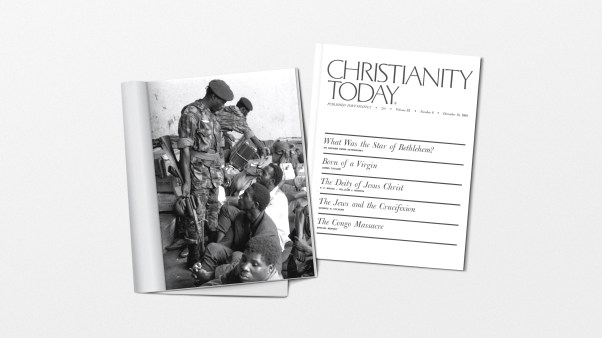Back from the Brink
A Church for the 21st Century by Leith Anderson (Bethany, $14.99)
The Consumer Church by Bruce Shelley and Marshall Shelley (InterVarsity, $9.99)
The Body by Charles Colson with Ellen Santilli Vaughn (Word, $19.99).
Reviewed by Gordon MacDonald, pastor of Grace Chapel, Lexington, Massachusetts.
Twenty-five years ago, useful books on the subject of the church were rare. I know; I used to look for them.
The church simply wasn’t a popular subject, and those who did write then-it’s my impression-usually speculated on the church’s demise, the decline of preaching, and the perceived irrelevance (a buzzword back then) of the gospel. We read things like God’s Frozen People and The Suburban Captivity of the Churches. Not a lot of hope in those days.
But that’s all changed now.
The church has been “rediscovered” and is in the process of being “reinvented” (organizationally) and re-presented. There appears to be a wonderful shift of initiative from the once powerful denominational, educational, and missionary/parachurch organizations to ministry innovators emerging from local congregations.
Suddenly scores of books are celebrating the church. Church growth principles, cell group dynamics, worship styles, preaching principles, evangelism techniques, “marketing” ideas, and organizational systems are among the hot topics.
But three recent books stick out as thoughtful. One comes from a pastor, another from a professor and journalist, and a third from (dare I use this phrase?) a contemporary prophet.
Changing with the times
The pastor, Leith Anderson, has provided remarkable leadership for Wooddale Church in Eden Prairie, Minnesota. The numerical growth of his church is impressive but not unique. What is more important is the way Anderson and his team have gone about orchestrating the growth. The principles underlying that process are reflected in his book, A Church for the 21st Century.
It’s a brand new day, Anderson says: “The church of the 21st century is dealing with a generation that is discouraged, depressed, tired, lonely and feeling guilty. They are more interested in learning what to do about their sins and struggles than being told they are sinners and strugglers.”
With such blunt observations, Leith Anderson paints a picture of the new world in which the church must pursue its mission. He describes a culture of paradigm shifts and changing demographics, of tight economies and addictive people.
On almost every page, you hear Anderson warning that the time-worn ways of doing church simply will not work in the 21st. Few “out there” listen or care any longer simply because the church announces it has something to say or plants itself in a neighborhood.
Anderson’s book confronts us with this question: Can the gospel challenge people of the new era? Clearly, Anderson believes the answer is yes.
He proposes a future in which small is beautiful: not small churches but small groups in larger churches “where everybody knows your name.”
He speaks to innovations in the way we learn and take in information: single-sense preaching (monologues in the pulpit, for example?) will hardly connect with a generation awash in sight, sounds, and interactive communication. His thinking will unnerve more than a few church leaders where a fortress mentality has prevailed.
I hear Anderson separating the medium from the message. The message has not changed, but the medium is up for grabs.
“The goal of making disciples for Jesus Christ,” writes Anderson, “may be reached by different roads. One is not right and the other wrong. The choice depends on the circumstances.”
Churches wanting to grow will have to get serious about risk. Flexibility in programming, relational appeal, entrepreneurial thinking will mark their way of life. Success will have a lot to do with how well a congregation’s leadership “decodes” the surrounding culture and brings its resources to bear in addressing those needs.
I like Anderson’s emphasis on listening. Leaders need to find out what people are saying inside and (this is important) outside the church about its life.
“People will seek out a congregation,” Anderson says, “whose symbols and symbol system cause them the least amount of trauma.” This is a smart observation, and it rebukes a tendency in some churches to face the world with an arrogant posture.
If you find yourself in a church where the preoccupation is on the inside life of the congregation and has no serious touch with the outside community, A Church for the 21st Century is for you. Smart pastors will buy it for their lay leaders and then stand back to watch the fireworks.
“The new-century church will be an updated version of the old-century church. It will differ in everything from cost to complexity. But both are the body of Christ and share the purpose of doing God’s work in God’s way, evangelizing non-Christians, and edifying Christians.”
– Leith Anderson in A Church for the 21st Century
What got us here
In The Consumer Church, Bruce Shelley, professor of church history at Denver Seminary in Colorado, joins with his son, Marshall, editor of LEADERSHIP, to talk about the historical dynamics that have led to churches such as the one Leith Anderson leads.
The Shelleys speak of bewildered saints in a new world where large segments of society have separated themselves from the influence of the church. Historically this is a shocking change because it represents a break in Western society that traditionally saw the church as the backbone of life and cultural values.
“The world we once knew has changed,” the Shelleys say. “Growing numbers of people, including many who attend church and profess belief in God, consider religion strictly a private matter. Religion [to them] is fine as long as it places no restrictions on behavior.”
If the church’s message was thin at times in previous centuries, it was at least the place where children were christened, couples married, and the dead eulogized. When a moral word was needed, the church was assumed to be a useful resource. The Shelleys state the obvious: this is no longer the rule.
But they go one step further and focus on the implications. This diminution of influence has pressured the church to become an institution of persuasion. Now it must convince people that its message is true. Those outside the circle of faith must be convinced that entering into faith is necessary. And those inside must be persuaded that obedience and discipleship are mandatory.
That need to persuade, the Shelleys suggest, leads to the modern concept of marketing and consumerism that marks today’s church as it presents itself to the world. For if one is a persuader, one must determine what is persuasive to the “persuadees.”
And once the persuader is fixed upon reaching people, the temptation grows to modify the message to fit whatever the “market” will bear.
So we are caught in a historical transition: from an authoritative establishment central to traditional culture to a group on the culture’s periphery that must sell its ideas.
The Shelleys offer valuable comment on the pre-Revolutionary days of Puritan spirit, a time when good people envisioned a Christianized America. But when state and church had to be separated, the need for the church to reach beyond itself became a reality.
“Shortly after the dawn of the eighteenth century,” the Shelleys write, “it was clear that the Puritans would have to relinquish their hold on power and win converts like everyone else, by voluntary means alone. This was the obvious fact behind America’s first revival.”
Thus: the emergence of compelling preaching, revivals and awakenings, evangelistic campaigns, and parachurch efforts all calling people out of darkness and into light. As times and technology changed, persuasion moved beyond just preaching to messages conveyed by music and media.
Having looked back, the Shelleys take a snapshot of today: a look at the Christian booksellers convention, megachurches, Christian radio and television.
About television: “The so-called electronic church is a hybrid of earlier American revivalism and modern secular television programming. Some evangelists on television, such as … Rex Humbard and Jimmy Swaggart … used the evangelistic strategies and techniques of Charles G. Finney, Dwight L. Moody and Billy Sunday, including the business techniques of promoting their messages through enterprising organizations.”
There are excellent chapters focusing on the evolution of preaching, worship, and leadership styles. The book concludes with a call to biblical balance: finding a way to engage culture with a compelling word, yet avoiding the tendency to be sucked into the methods and thinking of a world that is in actuality hostile to biblical interests.
If Leith Anderson suggests things church leaders can do, Marshall and Bruce Shelley provide things upon which to reflect. Anderson’s ideas are terrific, but it is helpful to set them in the framework of the Shelleys’ historical perspective.
“In the 1970s, the adventurous entrepreneurial spirit of Christian capitalism began drawing American religion closer to self-fulfilling individualism and further from Puritanism’s self-denial ethic. The evangelist’s message became enlistment rather than repentance. The focus was on joining rather than forsaking. By the 1980s the Lord’s business had become a growth industry.”
-Bruce Shelley and Marshall Shelley in The Consumer Church
The prophetic prod
Charles Colson, co-author of The Body, has filled a prophetic role in his many years as an author, speaker, and parachurch leader.
Prophets have never felt obligated to make their audiences feel good. And if that’s true Colson is reasonably successful. I didn’t find this to be a happy book. For the first 250 pages, I think it’s fair to say he spanks the church-at-large for its failure to be what he thinks it ought to be. I agree with what he thinks the church ought to be.
On koinonia Colson and Vaughn write, “Fellowship is more than unconditional love that wraps its arms around someone who is hurting. It is also tough love that holds one fast to the truth and the pursuit of righteousness.”
For many chapters I found myself first debating, then agreeing with Colson as he recounted the disturbing signs of an institutionalized church. What he sees as its shallowness, its sellout to marketing techniques, its abuses, its failure of nerve, causes him to diagnose the American church as out of control, diverted from its mission.
But more than once I winced because I have spent my life deep inside the church, and I have seen the marks of vitality and renewal that a large part of this book seems to ignore. Whenever Colson and Vaughn want to call attention to examples of vitality, they tend to point to Eastern Europe where there are, admittedly, some wonderful stories of Christian heroism. But it is unrealistic, I think, to compare the American church to the Eastern European one.
Heroism found on the streets of Timisoara (Romania) or Nowa Huta (Poland) is the result of enormous oppression in which life itself often hangs in the balance. History is replete with countless examples of strong persecution engendering a small but purified church, and heroes are its hallmark. Out of a suffering environment comes a deepened theology. My own experiences suggest that one’s theology goes only as deep as one’s pain. And the American church hasn’t hurt enough yet to achieve Colson’s vision.
In contrast, the curse of life in North America is that our “persecution” is far too subtle to produce heroes or heroic churches-at least the kind of heroes that make for great stories. Many American churches have bred “heroes” about which Colson could have written. I think I’ve seen a few of them in the congregations I have pastored.
These are the heroes who encounter the prisoner (much thanks to Colson himself), teach in literacy programs, work with the homeless, join disaster teams, and make their kingdom presence known in school systems, government offices, and the theater. Unfortunately, they aren’t considered heroes until they get beaten up or killed.
Colson and Vaughn write with courage on the “sin of presumption”: “The belief that there is but one method or formula by which we enter the kingdom is what we call the sin of presumption: presuming to know the mind of God and to program by human means who is or is not secure in the faith and hence in the church.”
They warn of the spirit of judgmentalism that marks all of us from time to time when we handle this marvelous gospel truth.
“It’s amazing how much time people spend judging those whose view or church traditions might differ from their own,” they write. “This quickly leads to arrogance and lovelessness and inevitably divides the Body, grieving the heart of God.” This is a strong word, and I love the authors for saying it.
When Colson and Vaughn get around to a more positive perspective in the final chapters, their examples are less about churches than they are about outstanding individuals who, it seems to me, would have served God as valiantly as they did with or without the church.
Nevertheless, there is the stirring account of the friendship between Bob McAlister and Rusty Woomer, a convicted murderer. The two men developed a remarkable relationship as Woomer faced execution in the South Carolina Death House. Perhaps Colson and Vaughn are telling us that when the church is healthy, these are the sorts of places that people like McAlister go and the sort of gracious ministry they achieve in the lives of men like Woomer.
“What the church needs most desperately is holy fear. The passion to please God more than the culture and community in which we spend these few, short years.”
-Charles Colson with Ellen Santilli Vaughn in The Body
As a pastor, I’m delighted with the contributions of Leith Anderson, the Shelleys, and Colson/Vaughn. They’ve given me some things to do, some understanding of why I’m going to do them, and some biblical values to hold high. I’m going to keep these books sitting on my desk for a while.
* * *
NEW AND NOTEWORTHY
Principle-Centered Leadership by Steven R. Covey, Summit, $20.00
Effective leaders operate centrifugally rather than centripetally; their inner values impact their outer world. So believes Steven Covey, founder and chairman of the Covey Leadership Center and author of the best-selling book, The Seven Habits of Highly Effective People.
Being trustworthy, trusting others, empowering people to succeed, and aligning people around a common vision-these are ways to become “principle-centered.” In the chapter, “Thirty Methods of Influence,” Covey says leaders should lead by allowing people to reap what they sow-let consequences teach correct behavior.
When Child Abuse Comes to Church by Bill Anderson, Bethany, $8.99
If you think sexual abuse can’t happen in your church nursery, think again, says Bill Anderson, pastor of a church where, before he arrived, 64 children were sexually molested and physically abused.
Three weeks into a new ministry, Anderson was faced with the unraveling of a sexual abuse nightmare. His experience lends keen insight to this growing problem. He punctuates this tragic story with how-to sections like, What do you do when the perpetrator is also a church member? How do you handle the inevitable media coverage? He also supplies guidelines to protect church children.
The Coming Revolution in Youth Ministry by Mark Senter, III, Victor, $12.99
In 1990 Time magazine asked, “What will the U.S. be like when whites are no longer the majority?”
The answer to that question, according to Mark Senter, professor at Trinity Evangelical Divinity School in Deerfield, Illinois, will pressure youth leaders in America to depart from the past ways of doing youth work. This new “cycle” involves “narrowcasting”-tailoring ministry to reach an increasingly heterogeneous and unreached youth culture. This will feature, among other things, a predominance of volunteer-led ministries, an increase in the number of women leaders, and an emphasis on student prayer and worship.
Preaching with Freshness by Bruce Mawhinney, Harvest, $12.99
Every preacher fears becoming stale and boring. Staying fresh is possible, though, by studying the Bible-not only to see what it says but how it says it. The way Bruce Mawhinney, pastor at New Hope Presbyterian Church in Monroeville, Pennsylvania, writes this book-a fast-paced, fictional narrative-illustrates his point. Through the art of storytelling, he creatively offers suggestions like how to reword old clichs and how to choose each sermon’s best method of delivery.
When Not to Build by Ray Bowman with Eddy Hall, Baker, $9.95
When your facility reaches 90 percent of its capacity, conventional wisdom says it’s time to build.
But not Ray Bowman, former church architect turned church-growth consultant, who says an existing facility can accommodate up to three times its current usage. When building does become the only alternative, though, Bowman offers advice on who should be involved in the process: ministry experts should plan the facility while construction experts build it.
-Chuck Stober
Coal Creek Community Church
Louisville, Colorado
* * *
Close Up
Raising Small Church Esteem by Steven E. Burt and Hazel A. Roper, The Alban Institute, $10.95
Authors: Steve Burt is director of the small church program at Missouri School of Religion. A graduate of both Bangor Theological Seminary and Andover-Newton Theological School, he is a consultant and editor of The Small Church Newsletter.
Hazel Roper is associate executive minister for the American Baptist Churches of New York State. A graduate of Andover-Newton Theological School, she served twenty years as pastor of Community Baptist Church, a small church in Plainfield, New Hampshire.
Main Help: Roper and Burt discuss how small churches can go from being “the little church that can’t” to the “little church that can.” When small churches focus on the benefits of being small-community, intimacy, participation, and cooperation-their self-esteem increases. Self-esteem plummets when they compare themselves with their larger suburban cousins.
Practical Takeaway: To raise their self-esteem, small churches could host a community-wide appreciation banquet for the local volunteer fire department, schedule a “Shopping Bag Sunday” to replenish the community food bank, write articles for small church newsletters, and encourage denominational leaders to include small church pastoral skills training as part of their seminary’s curriculum.
Key Quote: “Often small churches … accept a self-image dictated by society and the dominant culture, an image thrust on them by peer pressure, an image reinforced by failure or depression. In the process, their own God-given self-image is distorted, if not buried. The task is to rediscover that healthy self-image and to recover the small church’s esteem.”
Copyright © 1993 by the author or Christianity Today/Leadership Journal. Click here for reprint information on Leadership Journal.









